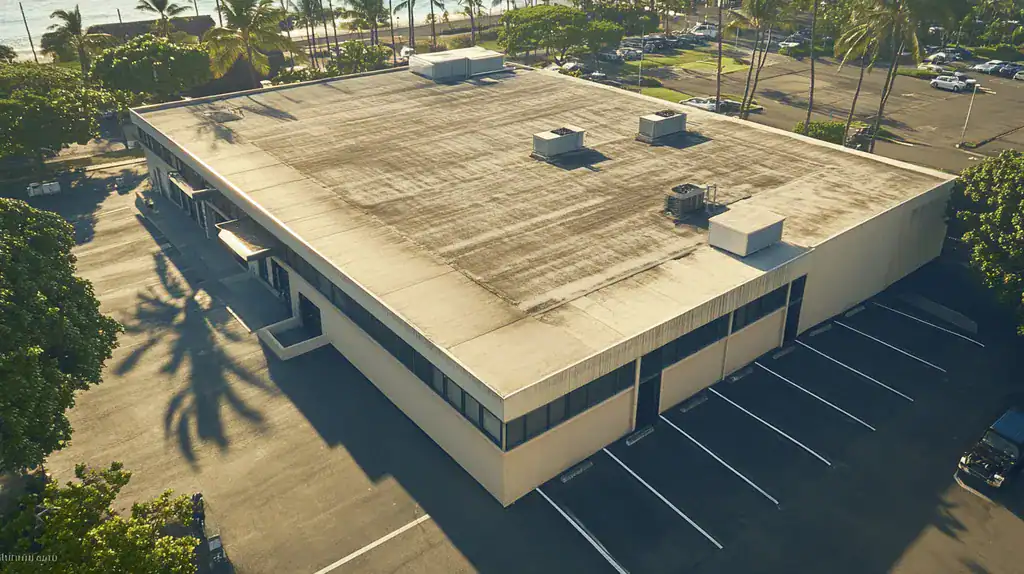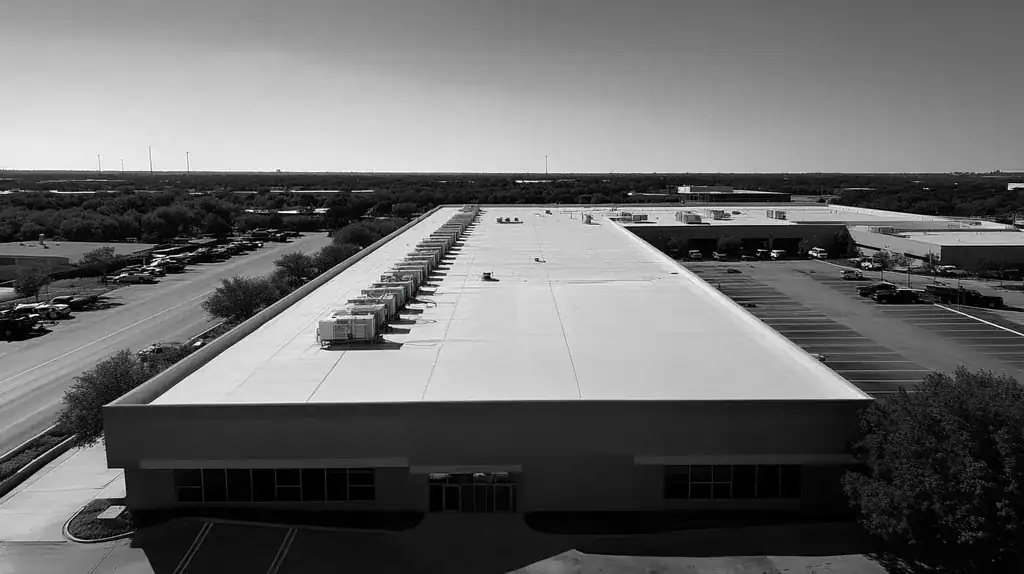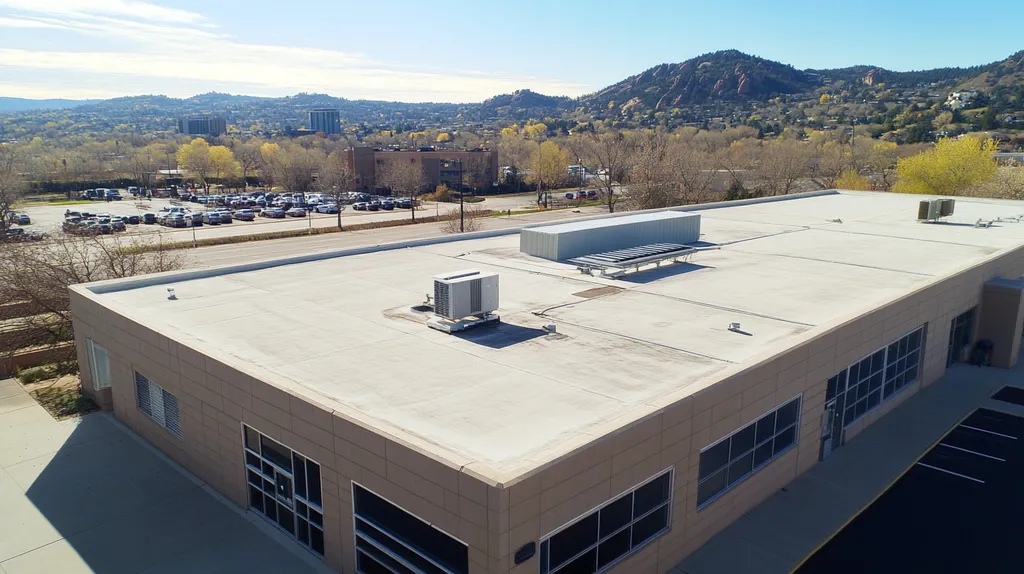In industrial facilities, roofing projects can trigger production losses exceeding $100,000 per day when poorly managed. Studies show that up to 40% of manufacturing operations face significant disruptions during roof installations or repairs.
Modern approaches to industrial roofing focus on maintaining operational continuity through strategic planning, advanced materials, and precise execution methods.
This comprehensive guide examines proven strategies for minimizing facility disruption, from initial material selection through final installation, enabling property managers to protect both their buildings and bottom lines.
SECTION 1: FUNDAMENTAL CONCEPTS
Industrial roofing projects can paralyze facility operations, with studies showing production losses of up to 40% during major installations or repairs. Beyond immediate workflow disruptions, poorly managed roofing projects create cascading effects that impact everything from worker safety to product quality. For manufacturing facilities, even minor roofing work can trigger expensive production line shutdowns, while distribution centers face critical challenges maintaining shipping schedules during roof repairs.
Understanding Disruption Sources in Industrial Roofing
The most significant disruptions stem from three primary sources: physical interference, environmental impact, and workflow interruption. Physical interference includes equipment placement, material staging, and worker access requirements that can block critical facility pathways.
Environmental impacts encompass dust, debris, and chemical odors that can contaminate production areas or compromise air quality. These factors often force facilities to shut down entire sections, creating bottlenecks throughout the operation.
Workflow interruptions occur when roofing activities conflict with normal facility operations. This includes noise that hampers communication, vibration that affects sensitive equipment, and restricted access to loading docks or storage areas.
Proper management of these disruption sources requires detailed planning and coordination between roofing crews and facility staff. Early identification allows for targeted mitigation strategies that can preserve operational continuity.
Impact of Roofing Materials on Operational Continuity
Material selection directly influences both installation time and operational impact. Modern single-ply membranes can reduce installation time by up to 60% compared to traditional built-up roofing systems, significantly decreasing facility disruption.
Storage requirements for different materials create varying levels of logistical challenges. Some materials demand extensive staging areas that can interfere with facility traffic patterns, while others allow for just-in-time delivery to minimize space requirements.
Installation methods associated with different materials also affect disruption levels. Hot-applied systems require equipment that can interfere with facility ventilation systems, while cold-applied alternatives often allow for more flexible installation scheduling.
The long-term maintenance requirements of different materials should factor into selection decisions. Materials requiring frequent maintenance can lead to recurring operational disruptions throughout the roof’s lifecycle.
Regulatory and Safety Considerations During Roof Work
Operations and maintenance best practices emphasize the critical nature of proper training and certification for all personnel involved in roofing projects. Following manufacturer specifications and industry guidelines helps minimize both safety risks and operational disruptions.
Well-designed O&M programs can significantly reduce costs and disruption during roof-related activities while ensuring compliance with safety regulations. This structured approach helps maintain operational continuity while protecting worker safety. (source: Pacific Northwest National Laboratory)
Safety protocols must address both roofing crew activities and facility operations. This includes establishing clear communication channels, defining emergency procedures, and creating buffer zones between work areas and operational spaces.
Compliance documentation requirements can impact project timelines and must be factored into planning. Having systems in place to track and verify regulatory compliance helps prevent costly work stoppages due to inspection failures.
SECTION 2: SYSTEM COMPONENTS
Every component choice in an industrial roofing system directly impacts operational continuity. Studies show that up to 30% of roofing project delays stem from inadequate material selection, leading to costly rework and extended facility disruptions. Making informed decisions about membranes, substrate materials, and installation methods can dramatically reduce project timelines while maintaining facility operations.
Durable Membrane Types to Minimize Rework
Modern roofing membranes offer unprecedented durability and installation efficiency. TPO and EPDM systems provide superior resistance to UV exposure and thermal cycling, reducing the likelihood of premature failure and subsequent disruptions.
Advanced membrane formulations now include self-adhering technologies that cut installation time by up to 40%. These innovations eliminate the need for separate adhesive applications, reducing both labor requirements and chemical exposure risks.
Membrane thickness selection critically impacts long-term performance. While 45-mil membranes meet basic requirements, 60-mil and 80-mil options provide enhanced puncture resistance and dimensional stability, significantly reducing maintenance disruptions.
Quality control during membrane production ensures consistent performance characteristics. This standardization leads to more predictable installation timeframes and fewer callbacks for repairs.
Role of Cover and Substrate Boards in Noise Reduction
High-density cover boards serve as crucial sound barriers during installation. These materials can reduce impact noise by up to 50%, allowing adjacent facility areas to maintain normal operations.
Proper substrate preparation through quality board installation creates an optimal surface for membrane attachment. This attention to foundation work prevents future disruptions caused by membrane separation or substrate deterioration.
Modern composite boards combine impact resistance with superior acoustic properties. These materials protect underlying insulation while dampening construction noise, creating a more manageable work environment.
Strategic board layout and attachment patterns minimize walking paths and reduce installation time. This systematic approach ensures efficient material distribution while maintaining noise control benefits.
Adhesives versus Fasteners: Impact on Installation Efficiency
Adhesive systems dramatically reduce installation time compared to mechanical fastening methods. Low-VOC formulations allow for continuous application without compromising indoor air quality or worker safety.
Modern spray-applied adhesives provide uniform coverage while reducing labor requirements. This consistency improves bond strength and eliminates common failure points that lead to future disruptions.
The elimination of mechanical fasteners through adhesive use reduces penetrations and potential leak sources. Fewer penetrations mean less long-term maintenance and fewer operational interruptions for repairs.
Efficient application processes reduce both installation time and rework requirements. The DoD Producibility and Manufacturability Engineering Guide emphasizes that reducing touch labor and minimizing steps significantly decreases defect and rework rates. (source: DoD Producibility and Manufacturability Engineering Guide)
SECTION 3: IMPLEMENTATION METHODS
Industrial roofing projects can cripple operations when poorly implemented, with studies showing disruption costs exceeding $50,000 per day in large facilities. Strategic implementation methods focused on timing, logistics, and communication can reduce operational impact by up to 75%. Understanding and applying these methods is crucial for maintaining productivity during roof work.
Scheduling Roof Work to Avoid Peak Business Hours
Off-peak scheduling requires careful analysis of facility operations to identify optimal work windows. Most industrial facilities experience natural downtime cycles that can accommodate roofing work without disrupting core operations.
Weather patterns and seasonal business fluctuations must factor into scheduling decisions. Planning roof work during traditionally slower periods allows for more flexible timelines and reduced pressure on installation teams.
Segmenting large projects into manageable phases helps maintain operational continuity. This approach allows facilities to isolate work areas and rotate through sections while keeping production lines active.
Regular inspections and preventive maintenance should be scheduled during planned downtimes to minimize unexpected repairs. Timely attention prevents emergency repairs that could force unplanned shutdowns. (source: Bonded Applicators)
Coordinating Logistics for Material Delivery and Waste Removal
Material staging requires strategic planning to prevent interference with facility operations. Establishing dedicated delivery zones and scheduling precise delivery windows helps maintain normal traffic patterns.
Just-in-time delivery systems can reduce on-site storage requirements by up to 60%. This approach minimizes the impact on parking areas and maintains clear access to loading docks.
Waste management protocols should include designated collection points away from high-traffic areas. Regular removal schedules prevent debris accumulation and maintain site safety.
Mobile storage solutions can help manage materials while preserving facility access. These units can be positioned strategically to minimize interference with daily operations.
Communication Strategies with Stakeholders and Occupants
Clear communication channels between roofing crews and facility staff are essential for coordinating work activities. Daily briefings help identify potential conflicts before they impact operations.
Digital notification systems can alert stakeholders to upcoming work phases and potential disruptions. This advanced warning allows departments to adjust schedules and workflows accordingly.
Creating detailed maps of work zones and access routes helps facility occupants navigate around roofing activities. These visual aids reduce confusion and maintain efficient facility movement.
Progress updates should include specific timelines and impact assessments. Regular communication helps maintain stakeholder confidence and ensures cooperation throughout the project.
SECTION 4: MAINTENANCE REQUIREMENTS
Effective maintenance strategies can mean the difference between continuous operations and costly shutdowns in industrial facilities. Studies show that neglected industrial roofs lead to emergency repairs costing 4-5 times more than planned maintenance. Beyond direct repair costs, unexpected roofing issues can force entire production lines to halt, creating devastating ripple effects throughout the supply chain.
Routine Inspection Protocols to Prevent Emergency Repairs
A comprehensive inspection program forms the foundation of preventive maintenance. Monthly visual inspections by facility staff can identify early warning signs like ponding water, membrane separation, or flashing deterioration before they escalate into major issues.
Detailed biannual professional inspections should include core sampling, seam testing, and drainage evaluation. These thorough assessments create a documented history of roof condition and performance trends.
Modern inspection technologies like infrared moisture detection and drone mapping enable non-invasive evaluation. These tools minimize disruption while providing detailed insights into potential problem areas.
The National Center for Educational Statistics emphasizes that comprehensive facility maintenance planning and routine inspections by trained staff are essential for sustaining operations during maintenance work. (source: National Center for Educational Statistics)
Maintaining Roof System Integrity During Facility Operation
Protecting the roof system during daily operations requires clear protocols and designated access paths. Marking approved walkways and equipment placement zones helps prevent accidental membrane damage from foot traffic or dropped tools.
HVAC maintenance and other rooftop activities demand careful coordination to avoid compromising the roofing system. Using temporary protection boards and establishing equipment-free zones around sensitive areas preserves roof integrity.
Regular cleaning of drains and removal of debris prevents water accumulation that can stress the roofing system. This ongoing maintenance can be performed during normal operations without disrupting work below.
Documentation of all rooftop activities helps track potential impact points and identify recurring issues. This data drives more efficient maintenance scheduling and reduces unexpected repairs.
Noise and Debris Control Measures for Ongoing Maintenance
Strategic scheduling of maintenance activities during off-peak hours minimizes operational impact. Night and weekend work allows for unrestricted access while reducing noise concerns for facility occupants.
Proper containment systems prevent debris from entering ventilation systems or contaminating production areas. Portable barriers and negative air pressure units isolate maintenance zones from active facility spaces.
Low-noise equipment options and sound dampening techniques reduce disruption during necessary daytime maintenance. Electric tools and rubber-wheeled carts significantly decrease noise compared to traditional maintenance equipment.
Clear communication protocols ensure facility staff can quickly respond to maintenance-related concerns. Establishing designated contacts and response procedures prevents minor issues from escalating into major disruptions.
SECTION 5: PERFORMANCE METRICS
Precise performance metrics drive successful industrial roofing projects, with ineffective measurement leading to 35% cost overruns and extended facility disruptions. Traditional approaches often fail to capture critical metrics that directly impact operational continuity. Comprehensive measurement strategies encompassing installation efficiency, environmental impact, and system longevity provide the foundation for minimizing disruption while maintaining production schedules.
Measuring Installation Duration and Occupant Impact
Installation duration tracking must account for both direct work time and associated facility adjustments. Advanced project management platforms can map critical paths while identifying potential conflict points with normal operations.
Real-time productivity monitoring helps identify efficiency bottlenecks before they cascade into broader disruptions. Digital tracking systems allow project managers to adjust crew assignments and material staging to maintain optimal workflow.
Impact assessment metrics should measure both planned and unplanned operational adjustments. This includes tracking production line modifications, temporary storage relocations, and changes to material handling routes.
Occupant impact scoring systems help quantify disruption levels across different facility areas. These metrics guide resource allocation and help prioritize work sequences to minimize operational interference.
Quantifying Noise Levels and Airborne Debris During Work
Continuous monitoring of noise levels through strategically placed sensors provides real-time data for managing disruption. This allows for immediate adjustments to work patterns when readings exceed facility-specific thresholds.
Airborne particulate measurement systems track both visible debris and microscopic contaminants. Understanding these patterns helps optimize containment strategies and ventilation adjustments.
The Pacific Northwest National Laboratory emphasizes that state-of-the-art monitoring technologies enable precise environmental control during maintenance activities, significantly reducing operational disruptions. (source: Pacific Northwest National Laboratory)
Integration of environmental metrics with production quality data identifies correlation between roofing activities and product defects. This information drives scheduling decisions and containment strategies.
Assessing Durability and Longevity of Roofing Systems
Lifecycle performance metrics must consider both immediate installation impact and long-term maintenance requirements. Advanced modeling tools can predict maintenance intervals and associated disruption patterns.
Material durability testing under facility-specific conditions provides more accurate service life estimates. This data helps optimize material selection to minimize future operational interruptions.
Performance degradation tracking through regular inspections and testing identifies early warning signs of system failure. Early detection allows for planned interventions rather than emergency repairs.
Documentation of repair frequency and scope helps quantify the true cost of different roofing systems. This comprehensive view includes both direct repair costs and associated operational disruptions.
SECTION 6: OPTIMIZATION STRATEGIES
Industrial roofing projects can reduce facility productivity by up to 40% without proper optimization strategies in place. Studies show that inefficient roofing approaches cost industrial facilities millions annually in lost production and operational disruptions. Strategic optimization through hybrid systems, advanced adhesive technologies, and continuous improvement protocols can slash installation times while maintaining crucial facility operations.
Selecting Hybrid Roofing Systems for Reduced Disruption
Hybrid roofing systems combine multiple proven technologies to maximize installation efficiency while minimizing facility impact. These systems can reduce installation time by up to 60% compared to traditional single-technology approaches.
The integration of prefabricated components with field-applied elements allows crews to complete major sections during off-peak hours. This strategic combination maintains facility operations while ensuring proper system installation.
Modern hybrid systems incorporate advanced materials that eliminate the need for torch-down or hot asphalt applications. This reduces both air quality impacts and fire risks that typically force facility shutdowns.
Performance data shows hybrid systems deliver superior longevity while requiring less intensive maintenance. The reduced maintenance burden translates to fewer operational disruptions throughout the roof’s lifecycle.
Leveraging Adhesive Technologies for Faster Installations
Advanced adhesive systems have revolutionized industrial roofing by eliminating mechanical fasteners in many applications. These technologies can reduce installation time by 40% while maintaining superior wind uplift resistance.
Low-VOC adhesive formulations enable continuous application without compromising indoor air quality. This allows facilities to maintain normal operations in adjacent areas during installation.
Spray-applied systems provide consistent coverage while reducing labor requirements and potential error points. The resulting uniform bond strength prevents future failures that could disrupt operations.
Quick-cure formulations allow for same-day water resistance, protecting facility operations from weather delays. This rapid deployment capability significantly reduces the vulnerability window during installation.
Continuous Improvement via Post-Project Reviews and Feedback
Systematic post-project analysis identifies opportunities to reduce disruption in future installations. The Pacific Northwest National Laboratory emphasizes that structured review processes combined with proper training create more efficient operations while maintaining system integrity. (source: Pacific Northwest National Laboratory)
Data collection during installation helps quantify actual versus projected disruption levels. This metrics-driven approach enables continuous refinement of installation methods and scheduling strategies.
Regular feedback from facility staff provides crucial insights into operational impact patterns. Understanding these patterns allows for more precise planning and improved coordination in subsequent projects.
Documentation of successful strategies creates a knowledge base for future optimization. This institutional memory helps prevent repeated disruptions from known challenges.
Moving Forward
With industrial roofing disruptions costing facilities up to $100,000 per day in lost productivity, the stakes for proper implementation have never been higher.
Modern materials, strategic scheduling, and advanced installation methods can reduce operational impact by up to 75% when properly coordinated.
The integration of hybrid systems and low-VOC adhesives continues to revolutionize industrial roofing, cutting traditional installation times nearly in half while maintaining facility operations.
Success requires a comprehensive approach incorporating detailed planning, precise metrics, and continuous improvement protocols.
As manufacturing demands intensify and operational margins tighten, facilities that embrace these disruption-minimizing strategies will maintain crucial competitive advantages in increasingly challenging markets.
FREQUENTLY ASKED QUESTIONS
Q. How can I minimize disruption during commercial roof installations?
A. Proper planning is essential to minimize disruption. Identify peak operation times and schedule roofing work during off-peak hours. Engaging with roofing crews and facility staff early can help coordinate tasks efficiently, ensuring minimal interference with daily operations.
Q. What factors affect disruption during industrial roof projects?
A. Key factors include physical interference, environmental impact, and workflow interruptions. Effective management of these elements involves detailed planning and communication between crews and facility staff, which can significantly reduce operational disturbances during roofing work.
Q. How can roofing materials impact commercial roof installation?
A. The choice of roofing materials can greatly influence installation time and long-term operational impact. Modern materials like single-ply membranes are quicker to install and require less maintenance, reducing potential disruptions and associated costs during the roofing lifecycle.
Q. What scheduling strategies help with industrial roof work?
A. Scheduling roofing projects during times of minimal operational activity is crucial. Analyze the facility’s natural downtime and consider local weather patterns to plan installations, ensuring that production continues with minimal disruption to routine activities.
Q. How can I prevent noise disruptions during roof maintenance?
A. To minimize noise, schedule maintenance during off-peak hours, such as nights or weekends. Utilize low-noise equipment and implement sound-dampening techniques. Clear communication around maintenance schedules can help prepare facility staff and mitigate noise concerns.
Q. What are common performance metrics for industrial roofing?
A. Key performance metrics include installation duration, noise levels, and material longevity. Monitoring these elements helps facility managers identify disruption points and optimize scheduling, ultimately reducing the impact of roofing activities on production workflows.
Q. What additional strategies exist for minimizing disruption?
A. Consider using hybrid roofing systems and advanced adhesive technologies for efficiency. Implementing continuous improvement protocols, including post-project reviews, helps identify successful strategies and refine future roofing projects to further minimize disruptions.










